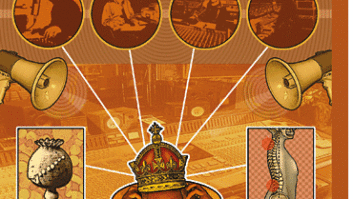WHAT YOU CAN DO ABOUT RSI, PART IISince I wrote last month’s “Insider Audio” on repetitive strain injuries in the recording studio, I came across this cogent explanation of why computer-related injuries are so much more prevalent now than a few years ago. It’s from an article written by Jonathan Bailin, a physiologist at the University of Southern California:
“Computers are now allowing us to do more office tasks which formerly allowed us to change activity. For example, a typewriter at one time required using a return carriage, `white out’ for mistakes, breaks for paper installation and getting up to file papers in a cabinet.
“Computer word-processing now eliminates these `microbreaks.’ In short, computers have greatly simplified office activity, an advance that has at least one important disadvantage. The danger is found in the possibility for long duration, continuous and relatively motion free, precise, muscular activity called `static exertion.’ Humans were not well `designed’ for this.”
In the recording studio, the equivalent to these “microbreaks” used to be tasks like changing reels on a tape deck, setting up mics and cables, adjusting outboard processing, reprogramming a patchbay, tweaking the parameters on a synthesizer or even emptying ashtrays (remember ashtrays?). With the integration of all of these functions (except the last) into the digital audio workstation, this variety of motions and postures has been replaced with a much smaller set of tasks: sitting in a chair, moving a mouse, clicking the mouse and pressing keys on a keyboard. In many studios, the engineer never even has to leave his or her seat to talk to the musicians – because they’re all electronic or DI’d, everyone’s in the same room, and the only mic that needs setting up is the lead singer’s.
All of this means that repetitive strain injuries (RSIs), Cumulative Trauma Disorders (CTDs, which are essentially the same thing) and other overuse injuries of the hand and arm are becoming as prevalent, if not more so, than the occupational hazard most familiar to audio engineers: hearing loss.
Last month’s column, if you missed it, is still available online at www.mixonline.com. This month, I’ll talk more about symptoms, types of treatments available, ways to change your work environment that might help and resources to consult if you are having computer-related problems with your hands and arms. I must say this again: I am not a trained medical professional, so please don’t consider this column to be medical advice. But I hope that by sharing some of my experience and what I’ve learned from professionals in the field, I can make you more aware of the new occupational hazards we face in today’s computerized studio. If you already have a problem, maybe this article can point you to some helpful directions.
Here’s a quick list of symptoms that might make you suspect you have an RSI or overuse injury:
– Tightness, achiness, stiffness, soreness, or burning in the hands, wrists, fingers, forearms or elbows;
– Tingling (“pins and needles”), coldness or numbness in the hands;
– Difficulty moving the hand or turning the wrist in a certain way;
– Clumsiness or loss of strength or coordination in the hands;
– Muscle spasms in the shoulder, sometimes followed by a sharp pain in the arm or wrist;
– Feeling a need to massage your hands, wrists or arms;
– Pain in your wrist, arm, back or neck that wakes you up at night.
What do you do if you experience any of these symptoms? The first thing is resting your hands and arms by cutting down on the amount of time you spend at the computer. Of course, it’s never easy to change your work schedule overnight, and Murphy’s Law states that the worst problems will occur when you’re on the most important project with the tightest deadline. But even just taking five minutes out of every hour and doing a few stretches (some good ones can be found on the Typing Injuries FAQ page where I saw Dr. Bailin’s article at tifaq.org) will help. Checking out your posture and taking corrective measures if you see you’re doing something wrong can help as well. Taking a couple of days off, if you can afford it, and resting your arms and hands will help even more.
In addition to rest, over-the-counter anti-inflammatory drugs, like aspirin or ibuprofen, can be useful; just don’t take large quantities of these on an empty stomach or without plenty of water. Try applying ice packs during resting periods: If there’s any swelling at all, this can calm it down. (Composer George Antheil, according to his extremely entertaining but somewhat dubious autobiography, claimed that in order to jump-start his performing career, he practiced the piano 16 to 20 hours a day. When his hands started to swell, he would place them in two fishbowls full of ice water until they were usable again. Maybe it worked for him, but I don’t recommend it.)
If the pain or discomfort lasts for more than a few days, it’s time to see a professional. Fortunately, the medical establishment has come a long way since the days when overuse injuries were diagnosed as being “all in your head,” and even in the sorry mess that our current health insurance system has become, most plans cover treatment for RSIs.
Most primary care physicians these days have at least a rudimentary knowledge of RSIs and can often offer a preliminary diagnosis. They can prescribe more powerful prescription anti-inflammatories, and sometimes a few days on those (combined with some new work habits) may be all you need. In some cases, cortisone injections may make sense for short-term relief from severe inflammation, particularly in the larger joints like the shoulder.
You also might get a recommendation for a simple over-the-counter wrist brace to help “enforce” rest – but unless you get specific advice otherwise, it’s usually a bad idea to try to continue working while you’re wearing a wrist brace; the motions you make to get around the restrictions of the brace may end up making your problems worse. Wear the brace only when you’re resting or, if your health professional says you should, when you sleep.
If the problem is serious enough (and it often is, or else you wouldn’t be there), the primary care physician will give you a referral to a specialist. In traditional medical practices and HMOs, this referral will often be to an orthopedist – another medical doctor who specializes in bones and joints – or a hand surgeon. There are some wonderful orthopedists and hand surgeons out there, but there are also some (as I alluded to in my last column) who seem to want to cut first and ask questions later. There are many, many other types of treatment you should investigate before you let anyone do any kind of surgery on your hands.
It might be worth your while to look outside the orthopedic community. Physiatrists (pronounced “FIZZ-e-AT-rists”) are M.D.s who specialize in the diagnosis and treatment of musculoskeletal injuries and pain syndromes, mostly through nonsurgical methods, and many of them have practices that specialize in RSIs. They often work closely with other non-M.D. specialists. Other non-M.D. professionals you might consider consulting are osteopaths, chiropractors, kinesiologists (muscle specialists) and massage therapists.
A lot of your choices will depend, alas, on the kind of insurance you have – some plans are more liberal than others at covering “alternative” therapies. One such therapy (or “modality,” as health professionals like to say) that is gaining greater acceptance in Western medical circles is acupuncture. I went to see an acupuncturist for an unrelated pain problem, and although we didn’t make much progress on my primary complaint, I found after a few sessions that my tendinitis, which had flared up earlier, completely disappeared. I also found it to be a thoroughly enjoyable form of treatment; all those endorphins floating around my system made for some of the most pleasant, relaxing “highs” I’ve ever had. Even better, my acupuncturist worked with a physiatrist and the M.D. did all the billing, so when I sent Blue Cross the bills, they didn’t even blink.
Some of the best treatment I’ve ever had from any medical provider has been at the hands (literally) of physical therapists and occupational therapists – the two are similar, but the latter are usually more specialized in their hand problem treatment. Help from PTs and OTs, in the form of teaching me exercises and stretches, simply heightens my awareness of when I’m doing something stupid to my body. Massage and ultrasound have significantly – and quickly – alleviated problems I’ve had with my knees, shoulders, back and hands. The custom splint I resort to occasionally to rest my hand was made for me by an occupational therapist, under the direction of an orthopedist, and as I said last month, it works great.
As I see it, the philosophy of PTs and OTs (as well as many other noninvasive types of treatment) revolves around teaching the body how to cure itself. Although I’m hardly the eat-organic, take-only-natural-herbs, never-trust-the-medical-establishment type, I find this idea enormously attractive. Medical insurers are slowly coming to accept physical and occupational therapy, and now, if you play your paperwork right, many plans will cover a reasonable number of visits to a practitioner.
The relationship you have with the provider can be as important as the type of treatment you choose. There needs to be a high level of trust that they know what’s wrong with you, and they know how to help you. They have to be able to listen to you and ask the right questions. You have to be able to listen to them and do what they tell you, whether it’s exercises, rest or adapting your work habits. If you think a professional is inattentive, incompetent, unknowledgeable or doesn’t take you seriously, find someone else. With RSIs, treatment is a two-way street. It’s not like curing strep throat with antibiotics; you are as responsible for your getting better as the professional you seek out.
For some, direct treatment from a professional may not be as helpful as (or may be enhanced by) developing a new mind/body discipline. There are many who have suffered with RSIs who have achieved relief through yoga, Tai Chi, Alexander technique or Feldenkreis method. Although the relationship is generally not as personal as with a medical professional, finding a good instructor who understands your problems and your goals is very important.
Given the number of people who have developed RSIs, it’s no surprise that the market has of late been flooded with various gadgets that claim to prevent or even cure overuse injuries caused by computers. But given the current make-a-fast-buck-any-way-you-can-and-the-government-doesn’t-care economic model, it’s also no surprise that many of these products are useless,and perhaps even harmful. Some devices are worthwhile only if used correctly; otherwise, they are dangerous. Wrist pads, for example, according to most professionals, should be used only when the hand is actually resting. If you type while your wrist is on the pad, the position it forces you into can aggravate carpal tunnel and tendon problems.
New kinds of keyboards are often touted as RSI preventers. The lateral angle of the wrist can be an important factor in wrist problems. The forearms and the wrist should approach the keyboard in a straight line, not at an angle. Keyboards that are split down the middle, with the different sides at different angles, are supposed to promote proper placement of the wrists and are useful for some. The Dvorak keyboard is designed to minimize the number and complexity of finger movements while typing. Conventional keyboards are designed to slow down typists to prevent the mechanisms in the first typewriting machines from jamming. But in a studio situation, a Dvorak keyboard may not be much help, since much of what we do isn’t straight typing, and the various key combinations used by DAWs aren’t necessarily going to make anymore ergonomic sense on a Dvorak keyboard than they do on a conventional one.
The mouse is a problem, especially when you’re doing very fine adjustments, like editing waveforms. Make sure the mouse you’re using fits in your hand naturally and doesn’t require any uncomfortable stretches to operate the buttons. (The new Macintosh “puck” mouse deserves to be buried in a landfill – if you have one, replace it.) For studio work, a trackball may be more suitable (although my experiences with one led to cramping in my fingers), and a drawing pad with a stylus can help in some tasks. Voice recognition software has improved by leaps and bounds in recent years, but it’s far more suitable for ordinary document creation than it is for studio work. (Can you say, “Open Insert 1 on channel 14, select Hall reverb, set diffusion to 80 percent and pre-delay to 40 msec, give me an LF boost of 1.6 dB at 500, goose the send level 3 dB, and route the return to aux 6?” I didn’t think so…)
If you talk on the phone a lot, get a hands-free headset so you don’t scrunch the phone between your neck and shoulders. You’d be surprised how fast and seriously this can hurt you. If you play a lot of video games at your computer, stop. If you have a hand problem, you want to increase the variety of motions and reduce tension; video games do exactly the opposite.
At the end of Return of the Jedi, Luke Skywalker gets fitted with an artificial hand that’s as good as his original. Technology has come a long way since that movie was made, but we still can’t do that. So it’s best to assume that the hands you have now are the only ones you’re going to have, and to quote Bob Dylan, “Take care of yourself and get plenty of rest.”
There is much more to learn about the issues surrounding RSIs and the studio, and I urge you, if you have a problem or are afraid of developing one, to check out the many resources available. The Internet, not surprisingly, is a great place to start. If you do a search for “RSI,” you will find tens of thousands of sites, so let me get you started by steering you to a few that I think contain solid information. All of them have many links to other sites, so feel free to surf away. Of course, typing in long Web addresses may be one of the things that got your hands in trouble in the first place, so all of these sites are just a mouse click away if you go to the Mix Web site, www.mixonline.com, and click on “Insider Audio.” The Web giveth, and the Web taketh away.
Here, then, are some places to get started:
– I’ve already mentioned the excellent Typing Injury FAQ site; for an article on that site that provides a good overview of RSIs: http://www.tifaq.org/articles/rsi_perspective-oct98-jackie_ross.html.
– A more formal, comprehensive article dating from 1988 is at www.sierranevada.edu/facilities/safety/musicsaf.htm.
– The RSI Network, www.ctdrn.org/rsinet.html, features a monthly newsletter, a mailing list, searchable archives and hundreds of articles from sources all over the world. Another mailing list for people with job-related hand issues can be joined at www.ucsf.edu/sorehand.
– www.engr.unl.edu/eeshop/rsi.html is a well-done page with information about posture, hand positioning and other factors, as well as a large catalog (with direct links to amazon.com) of books on the subject. It’s put together by someone who is not a professional in the field, but nonetheless, seems to know what he’s talking about. Another non-professional’s page, featuring an articulate and scary account of a journey through RSI Hell, is at www.amara.com/aboutme/rsi.html.
– Many universities host excellent sites. Check out the Harvard RSI Action Home Page, at www.rsi.deas.harvard.edu, Harvard Medical School’s RSI user group at neuro-www.mgh.harvard.edu/forum/Repet.StrainInjuryMenu.html, and MIT’s RSI Information Page at web.mit.edu/atic/www/rsi/mitrsi.htm.
– A commercial site with solid information is www.medicinenet.com. Type “carpal tunnel” in the search window, and you’ll be linked to several articles about the syndrome and its treatment.





